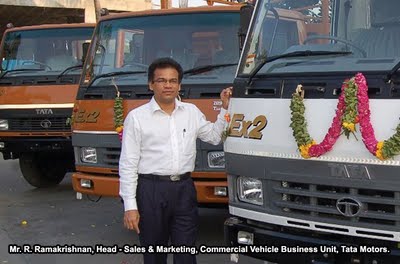
Talking to Motorindia at the launch of of LPT 1102 truck in Chennai, Ramki (as he is known to many in the industry), said, “the HCV segment is usually the first to enter the recession and the last to come out of it. Over the past few months the M&HCV; segment, which was in the red, has seen positive sales growth. In terms of cumulative sales we are still behind last year, but month on month we are narrowing the gap”.
The domestic CV industry registered a volume growth of 14.2 per cent during the second quarter of the current year, driven maonly by strong revival in industrial activities and cheaper finance. LCVs posted robust growth of 27 per cent y-o-y while on the other hand, the MHCV market recorded a decline marginally of (0.7) per cent during the quarter. The industry volumes in the MHCV truck segment declined by 10.5 per cent, while industry volumes in the LCV truck segment grew by 9.5 per cent during the quarter, driven mainly by the mini-truck segment.
Tata Motors’ Commercial vehicle business grew by 20.8 per cent, driven by a strong revival in the domestic industrial activities and cheaper finance availability. During the quarter (July-Sep’09), the company’s volume in M&HCV; segment grew by 5.3 per cent, first time since Q1FY09. Also LCV continued to clock robust growth and grew by 33 per cent, driven by continued success of ACE platform and LCV trucks and buses.The overall CV market share stood at 65.5% for the quarter; up 350 bps from 62.0% in Q2FY09.
The recovery has been across all regions but in a phased manner. Ramki said, “Northern region was probably the first to recover has been doing well right from the beginning of the year. East has been fairly stable except for the iron ore segment, which has not done well. West has recovered in September and South is just beginning to show signs of recovery” .
In terms of the segments, it is the multi-axle trucks which started recovering first. The tractor trailer segment is recovering but sporadically, in different pockets. The recovery is on account of cement and automobiles, likes cars in particular. The Tractor Trailer segment continues to be affected because of the dull exports. Latest figures show that exports are down 30% so far. Imports have increased to an extent and that has positively impacted the Tractor Trailer segment, Ramki adds.
Buses
Tata Motors has had a terrific run in the bus segment so far. During Apr-Sep’09 Tata Motors gained substantial market share in the Bus segment mainly due to greater acceptance of ICV Marcopolo and Super Milo buses. Also, Tata Motors gained market-share in the private and STU bus segment.  “The deliveries under the JNNURM project have started. We have an order book for 5000+ buses under the project and there is more expected”, says Ramki. On the luxury bus segment, the company offers the Hispano fully built bus. Tata Motors has sold close to 100 units so far.
“The deliveries under the JNNURM project have started. We have an order book for 5000+ buses under the project and there is more expected”, says Ramki. On the luxury bus segment, the company offers the Hispano fully built bus. Tata Motors has sold close to 100 units so far.
World Truck
Prima, which is the brand name for the World truck series, was launched in May last. The company has started deliveries of some vehicles. “The initial response has been good but as we mentioned right at the beginning, we are going slow on the deliveries. We don’t want to generate numbers to begin with. We want people to experience this concept, see what it does to the business. It’s a culture change for not just the the buyer of the truck but also the driver. Even our own sales and service infrastructure need to gear up for handling these trucks. We are preparing all the stake holders”, Ramki said. The Prima range includes Tractor-trailers, Rigid trucks, multi-axle trucks and tippers. “We will be gradually launching models as we go along and it will take atleast 18 months for us to reach a volume which is a representative figure in terms of sales in each segment”, Ramki said.
The Prima range includes Tractor-trailers, Rigid trucks, multi-axle trucks and tippers. “We will be gradually launching models as we go along and it will take atleast 18 months for us to reach a volume which is a representative figure in terms of sales in each segment”, Ramki said.
Through the World Truck, Tata Motors has demonstrated its intent to offer more fully built solutions. It has successfully achieved this in the bus and wants to replicate it in the truck segment as well.
“We would definitely like to move in the direction of fully built solutions as it helps the operator in many ways. It offers them better payloads; the vehicles are designed for better engineering and safety standards and therefore more reliable and durable. Most importantly the operator starts using the vehicle from day 1”, Ramki added.